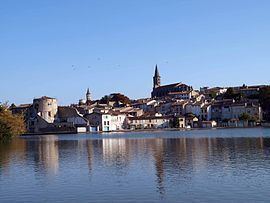INSEE/Postal code 11076 / 11400 Population 11,308 (2007) | Region Occitanie Time zone CET (UTC+1) Area 47.72 km² Local time Monday 8:29 AM | |
 | ||
Intercommunality Castelnaudary Lauraguais Audois Weather 8°C, Wind S at 6 km/h, 93% Humidity | ||
Castelnaudary (Occitan: Castèlnòu d'Arri) is a commune in the Aude department in the Occitanie region in south France. It is in the former province of the Lauragais and famous for cassoulet of which it claims to be the world capital, and of which it is a major producer.
Contents
- Map of 11400 Castelnaudary France
- Geography
- Roman staging post
- Origin of the name
- Major events
- Population
- Sights
- Personalities
- Education
- Foreign Legion base
- Cassoulet
- References
Map of 11400 Castelnaudary, France
Geography
Castelnaudary is a market town, and the capital of the territory of Lauragais. The town is located 50 kilometres (31 miles) southeast of Toulouse, about midway along the route from that city to the Mediterranean. This route has been used since at least Roman times, and today carries road, motorway (A61), rail and canal links. Castelnaudary is the main port of the Canal du Midi to which it owed a period of prosperity in the 17th century when agricultural and manufactured produce became easier to export. The Grand Bassin in the town is at 7 ha the largest open area of water in the canal, and is today its major pleasure port.
Roman staging post
In Roman times the location of the town was a staging post on the Narbonne-Toulouse road, and called Sostomagus.
Origin of the name
Castelnaudary comes from the Occitan Castèlnòu d'Arri, the Latin Castellum Novum Arri, or Arrius' new castle.
Major events
Population
Its inhabitants are called Chauriens.
Sights
Personalities
Castelnaudary was the birthplace of:
Education
Foreign Legion base
The 4th Foreign Regiment of the French Foreign Legion has been based in Castelnaudary since 1976, and the base is open to the public on 30 April (Camerone Day) and at Christmas.
Cassoulet
Castelnaudary styles itself Capitale Mondiale du Cassoulet ("World Capital of Cassoulet") and the apocryphal legend of the genesis of this dish (originally called estofat) relates that it was first served to the defenders of the town during the siege of 1355.
The town is home to the La Grande Confrérie du Cassoulet de Castelnaudary ("The Brotherhood of Castelnaudary's cassoulet"), an organisation which seeks to promote the dish and preserve its traditions. An annual festival celebrating cassoulet "fête du Cassoulet" is held in the last full week of August and the town centre is crowded with various versions of the traditional dish.
The cassoulet variant favoured in the town is based on the local haricot bean (which is the subject of a protected status application). It also includes goose or duck confit, pork, and Toulouse sausage.
Traditional peasant versions of the recipe can take two days or more to prepare. The traditional cooking vessel is an earthenware pot called a cassole for which the dish is named.
Rick Stein featured the Castelnaudary cassoulet in an episode of Rick Stein's French Odyssey and his recipe can be found on the BBC Food website.
